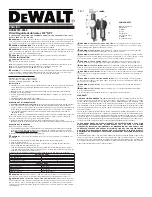
Series Progressive Lubrication Systems Installation Guide
L40000
Page 9
INSTALLING TUBING, PIPES, AND HOSES
(continued)
Use a deburring tool to remove all burrs from the bore of all
•
tubing sections that have been cut (see Figure 16).
Make sure all fittings are properly tightened to recommended
•
torque levels to prevent small leaks or weeping of lubricant.
Several manufacturers of tubing and pipe fittings offer detailed
training regarding proper installation practises should additional
information be desired or required.
Figure 16
CLEANING TUBING AND PIPES
When installing any type of fluid system, including lubrication
systems, thorough cleaning of tubing and pipes is essential
in order to ensure proper functioning and reliable operation.
The most criti cal time in the life of a fluid system is the initial
operating period. Any component manufacturing debris or
any contaminants added during the installation process that
are not cleaned out of the system before the first operating
period will be available for transport to other components,
bear ings, etc. Depending upon the amount and size, the debris
that has not been cleaned out of tubing or pipes and any
particulate contamination that has not been filtered out of the
fluid can potentially cause immediate damage, or else cause
future operating problems via cumulative degradation of any
components damaged during the first operat ing period of the
system. Therefore, to avoid any partial or complete failure
of the equipment when it is placed in operation, conductors
and other sys tem components must be thoroughly cleaned
and inspected prior to the system installation, assem bly, and
operation.
There are two recommended procedures for properly cleaning
tubing:
Pickling and Passivating Procedure
•
This method removes contamination such as cor rosion, scale,
slag, and weld spatter from pipes or tubing. The pickling
process uses an acidic solu tion that chemically loosens the
contaminants. This process should be used after any hot
bending, brazing, silver soldering, or welding without anti-slag
gas.
NOTE:
The pickling process is the preferred method of cleaning
pipes and tubing. However, due to the acidic chemicals and
detailed procedures required for perform ing the cleaning
operation properly, it is recommended that pickling be
performed only by an experienced professional pick ling
service.
Component Flushing Procedure
•
The flushing method is designed for cleaning tub ing before
its assembly into a system. This proce dure is especially
recommended for use after brazing tube fittings onto a piece of
tubing. The process mechanically loosens contaminants from
the inside of the tubing. High-pressure fluid is then applied to
flush out the loosened contaminants. This process is described
in greater detail in Component Flushing Procedure.
































